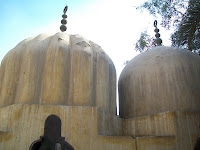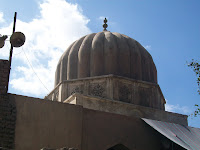You'll notice that I skipped "The Art and Architecture of Cairo 2." This is because I went on a fieldtrip without my camera. I may or may not blog about that trip. Yesterday I went to the City of the Dead, which is a cemetery inhabited by people. Please read about this area here. http://news.bbc.co.uk/2/hi/middle_east/8193812.stm
Our first stop was the Sayyida, or Lady, Ruqayya Mashad. A mashad is a shrine or memorial to a member of the Prophet's family. This is a Shiite tradition, which is against Sunni Islam. Even though Egyptians are Sunnis, many of them visit the shrines. Next, we looked at the Sayyida 'Akita and al-Gafari Mashads.
Our first stop was the Sayyida, or Lady, Ruqayya Mashad. A mashad is a shrine or memorial to a member of the Prophet's family. This is a Shiite tradition, which is against Sunni Islam. Even though Egyptians are Sunnis, many of them visit the shrines. Next, we looked at the Sayyida 'Akita and al-Gafari Mashads.
 Let's take a quick look at the domes of these mashads. Al-Gafari's dome (right) is simple; while, Sayyida 'Atika's dome (left) is more complex because it is ribbed on the outside. This tells us that the latter mashad was built later. Now let's compare them to Sayyida Ruqayya's dome, which is also ribbed. Directly below its dome, there is a section called the drum. In this case, it has windows with decorative stucco grills. This is a more complex development in
Let's take a quick look at the domes of these mashads. Al-Gafari's dome (right) is simple; while, Sayyida 'Atika's dome (left) is more complex because it is ribbed on the outside. This tells us that the latter mashad was built later. Now let's compare them to Sayyida Ruqayya's dome, which is also ribbed. Directly below its dome, there is a section called the drum. In this case, it has windows with decorative stucco grills. This is a more complex development in  architecture, and it tells us that both al-Gafari and Sayyida 'Atika were built before Sayyida Ruqayya. This is significant because out of these three mashads, the only one with an inscription including a date is Sayyida Ruqayya, which was built in 1133.
architecture, and it tells us that both al-Gafari and Sayyida 'Atika were built before Sayyida Ruqayya. This is significant because out of these three mashads, the only one with an inscription including a date is Sayyida Ruqayya, which was built in 1133.

 When we wanted to get back to the hotel, we expected to do the same thing even though traffic was heavier. While waiting for an opportunity to dash across the street, an Egyptian man made it clear that we shouldn't cross. He gestured down the sidewalk, and I thought that he wanted us to cross further down. As it turns out, there is a tunnel under the highway so that you don't have to run across it. What a luxury!
When we wanted to get back to the hotel, we expected to do the same thing even though traffic was heavier. While waiting for an opportunity to dash across the street, an Egyptian man made it clear that we shouldn't cross. He gestured down the sidewalk, and I thought that he wanted us to cross further down. As it turns out, there is a tunnel under the highway so that you don't have to run across it. What a luxury!
